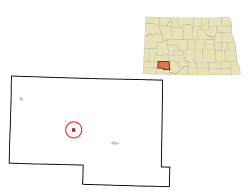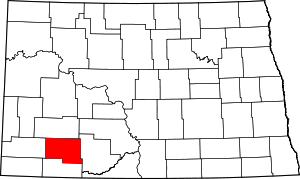Regent, North Dakota
Regent is a city in Hettinger County, North Dakota, United States. The population was 160 at the 2010 census.[5]
Regent, North Dakota | |
|---|---|
 Location of Regent, North Dakota | |
| Coordinates: 46°25′19″N 102°33′26″W | |
| Country | United States |
| State | North Dakota |
| County | Hettinger |
| Area | |
| • Total | 0.56 sq mi (1.45 km2) |
| • Land | 0.56 sq mi (1.45 km2) |
| • Water | 0.00 sq mi (0.00 km2) |
| Elevation | 2,461 ft (750 m) |
| Population | |
| • Total | 160 |
| • Estimate (2019)[3] | 157 |
| • Density | 280.36/sq mi (108.29/km2) |
| Time zone | UTC-7 (Mountain (MST)) |
| • Summer (DST) | UTC-6 (MDT) |
| ZIP code | 58650 |
| Area code(s) | 701 |
| FIPS code | 38-66020 |
| GNIS feature ID | 1030876[4] |
History
Regent was founded in 1910 when the railroad was extended to that point.[6] The city was so named with the aim of promoting its central location in order to attract the county seat.[7] A post office has been in operation at Regent since 1910.[8]
Geography
Regent is located at 46°25′19″N 102°33′26″W (46.421937, -102.557208).[9]
According to the United States Census Bureau, the city has a total area of 0.56 square miles (1.45 km2), all of it land.[10]
Demographics
| Historical population | |||
|---|---|---|---|
| Census | Pop. | %± | |
| 1920 | 262 | — | |
| 1930 | 308 | 17.6% | |
| 1940 | 261 | −15.3% | |
| 1950 | 405 | 55.2% | |
| 1960 | 388 | −4.2% | |
| 1970 | 344 | −11.3% | |
| 1980 | 297 | −13.7% | |
| 1990 | 268 | −9.8% | |
| 2000 | 211 | −21.3% | |
| 2010 | 160 | −24.2% | |
| Est. 2019 | 157 | [3] | −1.9% |
| U.S. Decennial Census[11] 2018 Estimate[12] | |||
2010 census
As of the census[2] of 2010, there were 160 people, 80 households, and 47 families residing in the city. The population density was 285.7 inhabitants per square mile (110.3/km2). There were 120 housing units at an average density of 214.3 per square mile (82.7/km2). The racial makeup of the city was 97.5% White, 1.9% Native American, and 0.6% from two or more races.
There were 80 households, of which 16.3% had children under the age of 18 living with them, 50.0% were married couples living together, 7.5% had a female householder with no husband present, 1.3% had a male householder with no wife present, and 41.3% were non-families. 41.3% of all households were made up of individuals, and 21.3% had someone living alone who was 65 years of age or older. The average household size was 2.00 and the average family size was 2.70.
The median age in the city was 52 years. 16.9% of residents were under the age of 18; 4.4% were between the ages of 18 and 24; 16.3% were from 25 to 44; 33.2% were from 45 to 64; and 29.4% were 65 years of age or older. The gender makeup of the city was 51.9% male and 48.1% female.
2000 census
As of the census of 2000, there were 211 people, 99 households, and 62 families residing in the city. The population density was 385.8 people per square mile (148.1/km2). There were 126 housing units at an average density of 230.4 per square mile (88.5/km2). The racial makeup of the city was 98.58% White and 1.42% Native American. Hispanic or Latino of any race were 0.47% of the population.
There were 99 households, out of which 21.2% had children under the age of 18 living with them, 53.5% were married couples living together, 8.1% had a female householder with no husband present, and 36.4% were non-families. 36.4% of all households were made up of individuals, and 26.3% had someone living alone who was 65 years of age or older. The average household size was 2.13 and the average family size was 2.75.
In the city, the population was spread out, with 23.2% under the age of 18, 1.9% from 18 to 24, 19.9% from 25 to 44, 20.4% from 45 to 64, and 34.6% who were 65 years of age or older. The median age was 50 years. For every 100 females, there were 91.8 males. For every 100 females age 18 and over, there were 100.0 males.
The median income for a household in the city was $24,250, and the median income for a family was $29,688. Males had a median income of $25,000 versus $13,333 for females. The per capita income for the city was $11,857. About 17.9% of families and 21.5% of the population were below the poverty line, including 38.9% of those under the age of eighteen and 10.1% of those 65 or over.
Business
Regent gained a moment of national notoriety when The Wall Street Journal published an article about a dispute among its telephone service providers. Consolidated Telephone Cooperative was the sole provider, but Western Wireless Corp. moved into town, providing service by cellular connection and thus saving the costs of installing wires. Angered by the loss of its customers, Consolidated refused to connect calls to and from Western's central switch, effectively disconnecting all of Western's customers in town. Western complained to regulatory authorities, and Consolidated agreed to connect the disconnected customers. The Journal noted that issues of possible monopoly, alleged illegal anticompetitive practices, and the preservation of established rural carriers (and their subsidies) in the face of competition from new rivals were potentially at stake.[13]
Arts and culture
Regent is home to the "Enchanted Highway", a series of metal sculptures by artist Gary Greff. Greff and the town of Regent were featured on the "NBC Nightly News" on August 26, 2007. The Hettinger County Historical Society Museum is located in Regent. The Regent area is acclaimed for its pheasant hunting.
Notable people
- Byron Dorgan: state Tax Commissioner (1969-1980), U.S. Congressman (1981-1992), and Senator (1992-2011)
References
- "2019 U.S. Gazetteer Files". United States Census Bureau. Retrieved July 27, 2020.
- "U.S. Census website". United States Census Bureau. Retrieved June 14, 2012.
- "Population and Housing Unit Estimates". United States Census Bureau. May 24, 2020. Retrieved May 27, 2020.
- "US Board on Geographic Names". United States Geological Survey. October 25, 2007. Retrieved January 31, 2008.
- "2010 Census Redistricting Data (Public Law 94-171) Summary File". American FactFinder. United States Census Bureau. Retrieved May 2, 2011.
- North Dakota: Counties - Towns & People, Part III. Watchmaker Publishing, Ltd. 2008. p. 175. ISBN 978-1-60386-342-1.
- Federal Writers' Project (1938). North Dakota, a Guide to the Northern Prairie State,. WPA. p. 229. ISBN 978-1-62376-033-5.
- "Hettinger County". Jim Forte Postal History. Retrieved October 25, 2015.
- "US Gazetteer files: 2010, 2000, and 1990". United States Census Bureau. February 12, 2011. Retrieved April 23, 2011.
- "US Gazetteer files 2010". United States Census Bureau. Archived from the original on February 20, 2011. Retrieved June 14, 2012.
- United States Census Bureau. "Census of Population and Housing". Retrieved March 23, 2014.
- "Population Estimates". United States Census Bureau. Retrieved June 27, 2019.
- Gruley, Bryan, "Battle lines: as phone wars move to rural towns, tactics are growing rougher; fighting for clients, cash from subsidiaries, upstart finds its main cable cut; 'not the 900-pound gorilla.'" The Wall Street Journal 1999.
External links
| Wikivoyage has a travel guide for Regent. |
